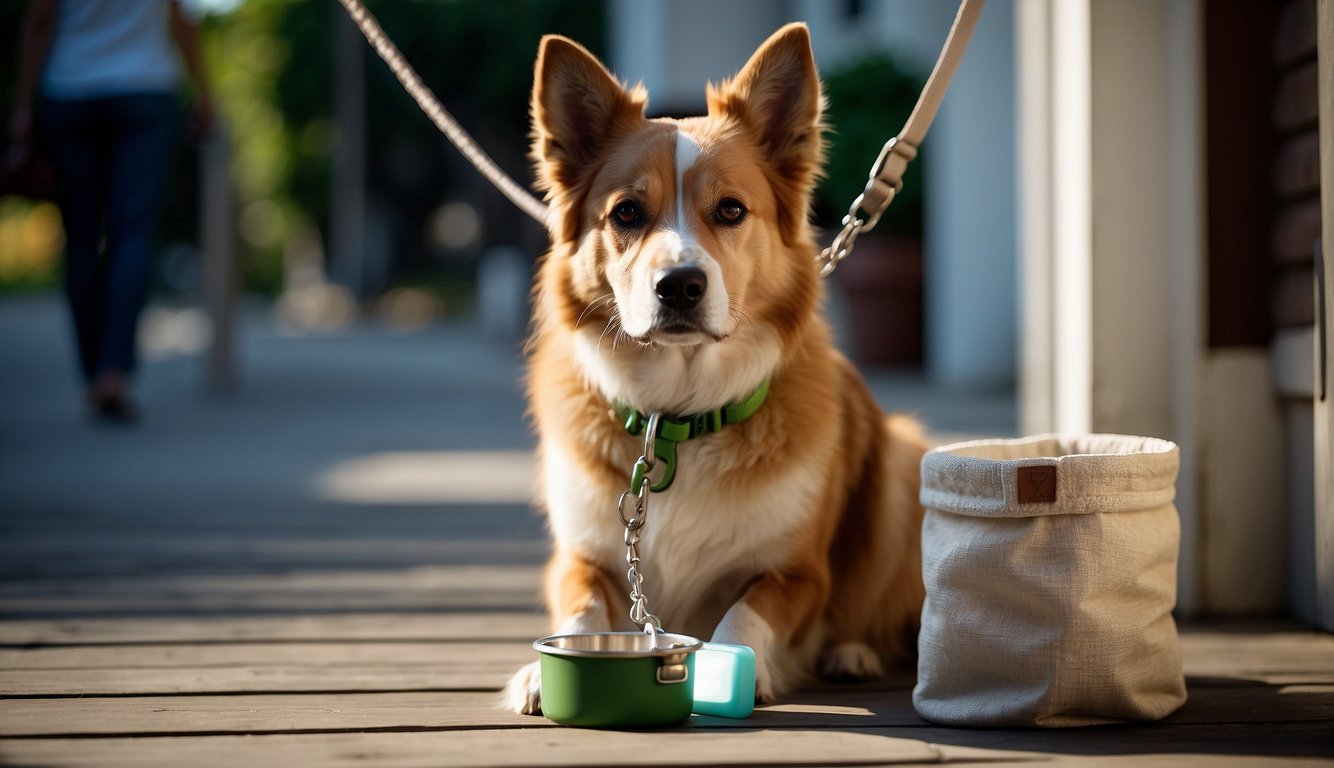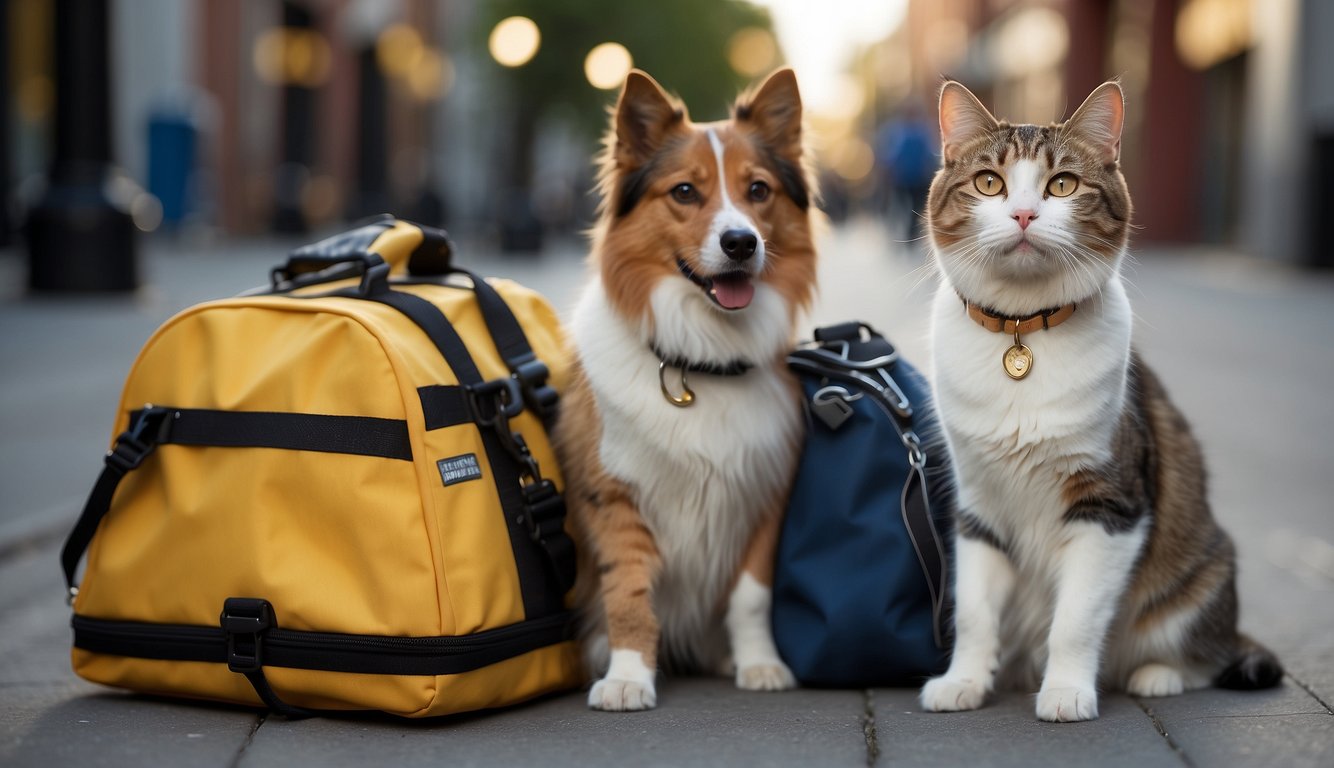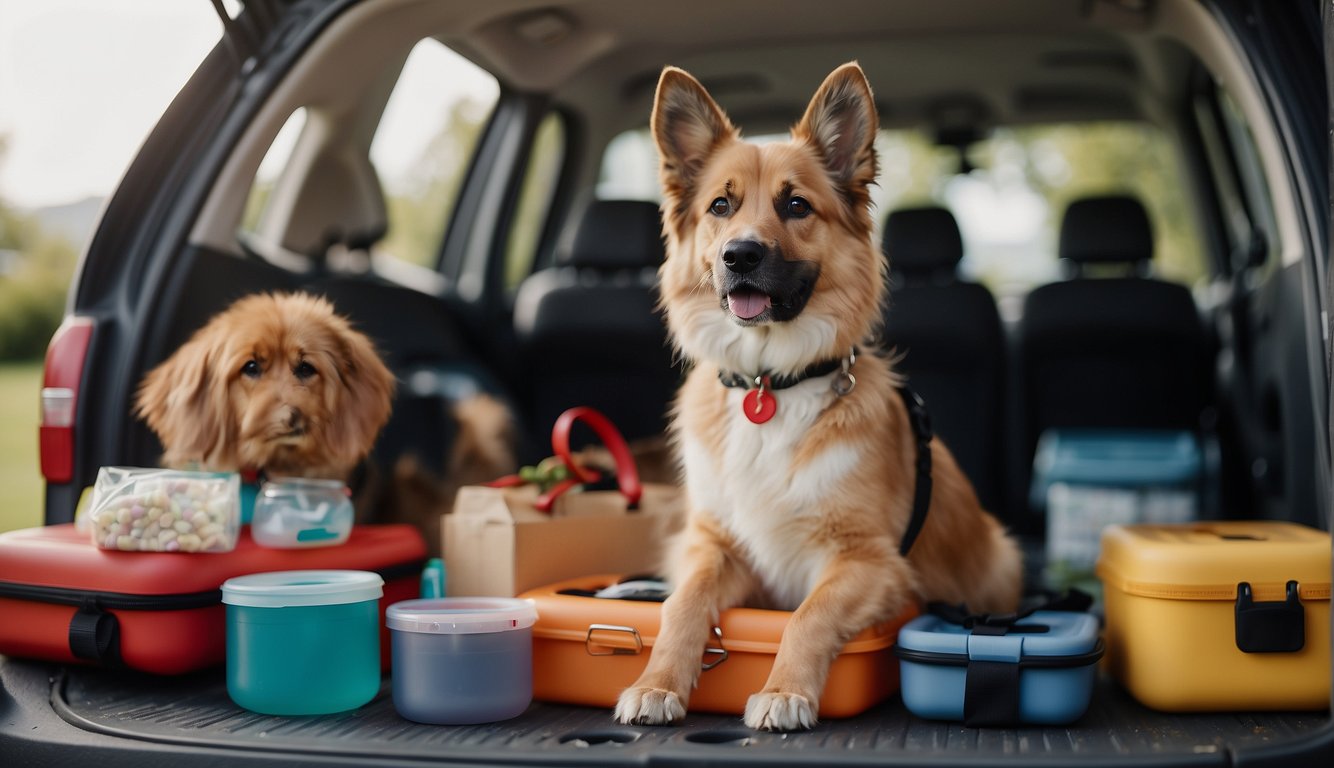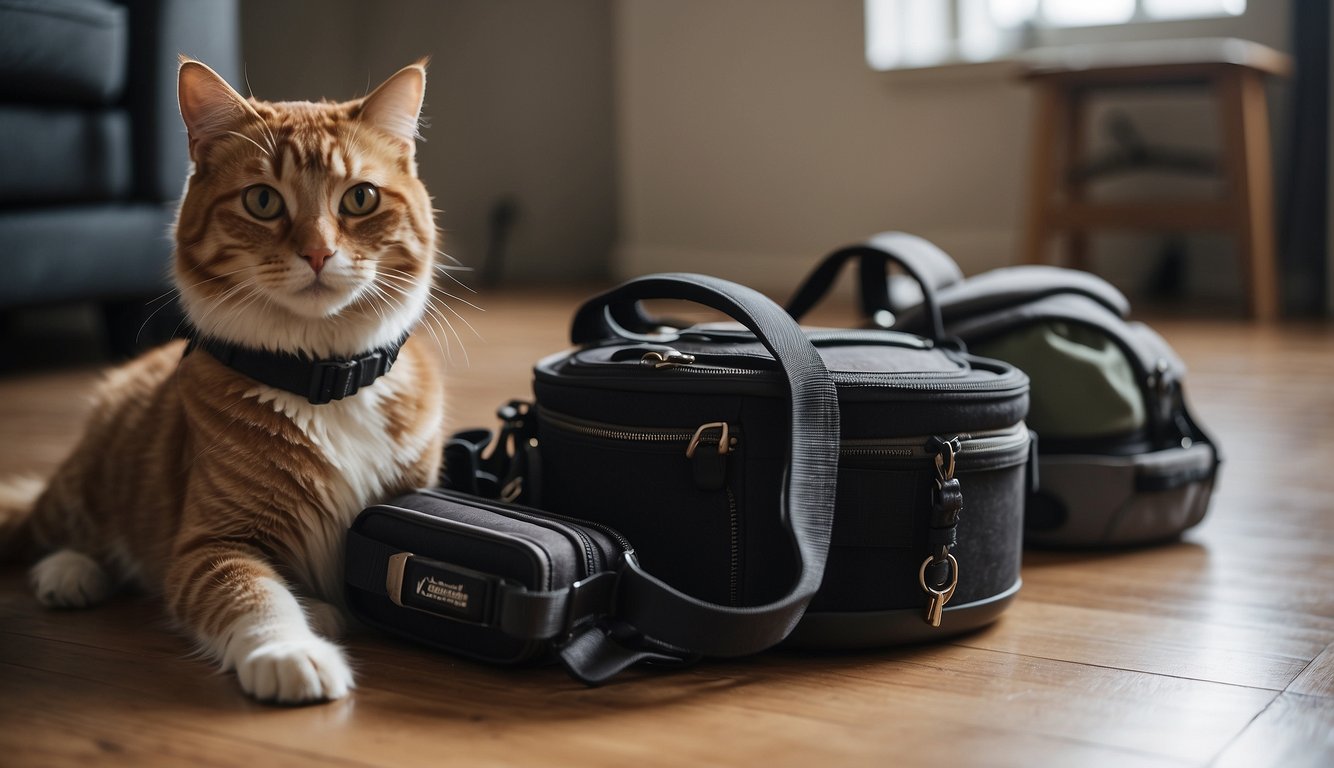
When confronted with an emergency situation, ensuring the safety of your pets is as vital as your own preparedness. Bugging out with pets requires careful planning and consideration of the unique challenges that come with having animals in tow. It’s essential to recognize that your pets depend on you for their safety and well-being. Some groundwork and forethought can significantly ease the process of evacuating with pets during a disaster.
Your strategy should account for the individual needs of each pet, such as their dietary requirements, medical needs, and transportation. Preparing a pet bug out bag alongside your own, microchipping for identification, and ensuring your pets are comfortable with travel carriers or harnesses can make a significant difference during an evacuation. Understanding the nuances of pet safety, logistical requirements for mobility, and the emotional comforts needed for your animal companions are also crucial elements of your bug out plans.
Key Takeaways
- Effective planning can ensure the well-being of pets in an emergency.
- Tailoring your preparations to meet specific pet needs enhances safety.
- Advance arrangements for pet mobility contribute to smoother evacuations.
Understanding Bugging Out
When considering a bug out scenario, you’re planning for a swift, strategic evacuation in response to imminent threats like natural disasters, potential war, or the imposition of martial law. The essence of bugging out is to move from an area of danger to a pre-determined bug out location—a place of safety where you can sustain yourself and your dependents, including pets, for an indefinite period.
To effectively bug out, your plan should encompass the following aspects:
- Preparation: Ensure you have a bug out bag (BOB) ready with essential supplies to last several days.
- Route Planning: Identify multiple routes to your bug out location to avoid congestion and potential roadblocks.
- Communication: Establish a communication plan with your family or group, so everyone knows what to do and where to go.
Key Considerations:
- Timeliness: You should be ready to leave at a moment’s notice, which means regular drills and knowing exactly what to pack.
- Safety: The safety of your route and bug out location must be a priority; this helps avoid jumping from one risky situation into another.
- Sustainability: Your bug out plan must include a sustainable setup at the bug out location, possibly with provisions for growing food, sourcing water, and maintaining hygiene.
Remember, the goal is to smoothly transition from a place of risk to a secure location with minimal interruption to your well-being and that of your pets. Your bug out plan is your lifeline; it needs to be reliable, tested, and ready to execute.
Planning and Preparation

When you’re planning to bug out with your pets, it’s crucial to have all the necessary gear and information readily accessible. The right bug out bag and supplies can be a game-changer in an emergency situation.
Choosing a Suitable Bug Out Bag
Your bug out bag (BOB) for your family pet should be sturdy, comfortable for them if they need to be carried, and spacious enough to hold supplies for at least 72 hours. Consider separate compartments for food, water, and medical supplies to stay organized. For larger dogs, invest in a dog backpack so they can carry their own supplies without being overburdened.
- Bag Choice: Go for durability and comfort.
- Compartments: Organize items into categories.
- Pet Carriers: Ensure they are adequately sized for your pet.
Determining Necessary Supplies
Stock your BOB with essential supplies that cater specifically to your pet’s needs. Include a sufficient amount of food and water, a portable bowl, a leash or harness, waste disposal bags, and medications. Remember to pack a first-aid kit and familiar items to reduce stress.
- Food and Water: Minimum 72-hour supply.
- First-Aid Kit: Bandages, antiseptics, and tweezers for tick removal.
- Comfort Items: Toys or blankets for emotional support.
- Medications: Include a supply of any medications your pet requires.
Creating an Emergency Preparedness Plan
An effective emergency preparedness plan includes identifying safe destinations and practicing evacuation routes with your pet. Store important documents such as vaccination records and registration in waterproof containers. Ensure your pet’s identification is up-to-date, with tags and microchips to aid in recovery if you get separated.
- Evacuation Routes: Practice and have alternatives planned.
- Important Documents: Vaccination records, ownership papers, and recent photos.
- Pet Identification: Verify that tags and microchip information are current.
Your plan should take into account the specific requirements your family pet will have and how to effectively manage their well-being during an evacuation scenario. To maximize success, rehearse your plan with all family members, including your pet, to ensure everyone is familiar with the procedures.
Pets and Their Needs

When you’re planning to bug out with your pets, you must consider their specific needs for food and water, shelter and comfort, as well as their health requirements, including necessary medications.
Food and Water Requirements
For dogs and cats, you should pack at least a three-day supply of food. Opt for dehydrated food as it is lighter and takes up less space but ensure you carry extra water to rehydrate it. The daily water requirement for dogs is about 1 ounce of water per pound of body weight, and cats need approximately 5 ounces of water per day to prevent dehydration. Always have a steady supply of clean water and consider water purification methods or carry water purification tablets.
- Dog: 1 oz of water/pound of body weight/day
- Cat: 5 oz of water/day
Shelter and Comfort
Your pets’ shelter and comfort are vital in times of stress. For cats, a portable and secure carrier is necessary, while dogs may need a muzzle and a sturdy leash. An ID tag on the collar is a must. Bring along a pet bed or blanket for comfort and warmth. Carry an extra tarp or portable shelter for protection from the elements.
- Carrier: Necessary for cats
- Leash and Muzzle: For dog control and safety
- ID Tags: Essential for all pets
Health and Medications
Maintain a pet first aid kit that includes bandages, antiseptics, and custom medications your pet may be on. If your pet needs prescription medications, pack at least a two-week supply. Remember to include tick and flea prevention as well as supplements if they are part of your pet’s daily regimen.
- First aid kit
- Two-week supply of medications: Essential for pets on chronic medication
- Flea and tick prevention: Necessary for outdoor conditions
Always consult with your veterinarian to confirm the specific amounts and types of food, water, and medications suitable for your individual pet’s needs before setting out.
Handling Various Types of Pets

When bugging out with pets, you must cater to the specific needs of each type of animal, whether that’s with a collar and leash for dogs or a secure carrier for cats. Ensure that your preparations consider transport, control, and the well-being of your pets in stressful situations.
Dogs and Their Specifics
Dogs require sturdy leashes and collars or harnesses for effective control and identification. It’s vital to have your dog’s pet bug out bag ready, including food, water, a bowl, and a toy to keep them calm. For dogs uncomfortable with chaos, consider a muzzle to prevent biting.
- Transport: A large enough carrier or harness system for securing them in a vehicle.
- Control: Reliable leash and harness; training in place to follow commands under stress.
- Comfort: Familiar items to reduce anxiety and specific care instructions.
Cats and Considerations
Cats often require a secure and comfortable carrier for transportation, as they can be more prone to stress and escape attempts. A pet bug out bag for cats should include litter, a portable litter tray, food, water, and a favorite blanket or toy for comfort.
- Transport: Escape-proof carrier that allows for bedding to absorb accidents.
- Control: Harness and leash for situations where they need to be outside of the carrier.
- Comfort: Items from home to create a familiar environment in the carrier or temporary shelter.
Other Animals and Considerations
For other animals such as birds, reptiles, small mammals, or farm animals, special considerations are needed.
- Small Animals: Secure travel cages with sufficient bedding, and an extra water bottle.
- Reptiles: Portable heating pads or lamps if the evacuation is to a cooler climate.
- Birds: Covered cages to prevent escape; calming music can be soothing.
- Farm Animals: Advanced planning for transport vehicles like trailers and knowledge of evacuation routes appropriate for large animals.
Keep in mind the specific needs of each animal to ensure their safety and reduce stress during an emergency evacuation.
Transportation and Mobility

In a bug-out scenario, ensuring the safe and secure travel of your pets is paramount. Your choice of transportation, as well as the methods to keep your pets secure and comfortable, are essential to a successful evacuation.
Securing Pets during Travel
Leashes and Carriers: Your pet’s safety is reliant on proper restraint systems. For dogs and cats, use a crash-tested carrier or a pet seatbelt harness to secure them in your bug-out vehicle. This not only ensures their safety but also minimizes distraction to the driver, contributing to the overall security of all passengers.
- Leashes should be reliable and fit well.
- Carriers need to be size-appropriate and ventilated.
- Always attach identification tags bearing your contact information.
Vehicle Preparations: Customize your vehicle to accommodate pet carriers securely. Non-slip surfaces and barriers can help prevent movement of carriers within the vehicle, ensuring they remain stable even when navigating obstacles or impassable routes.
Adjusting to Different Transport Methods
Adaptability: Whether you’re traveling by your personal bug-out vehicle, on foot, or through public transportation, your pet should be accustomed to various forms of mobility. Start by gradually exposing them to the carrier and vehicle environment.
- Personal Vehicles: Train your pet to enter and exit their carrier calmly, and ensure they are comfortable in your vehicle. Practice with short drives, gradually increasing in duration.
- Public Transport: Understand the regulations and requirements for pets when using alternate transportation methods. Knowledge of these rules can expedite your movement during an evacuation.
By thoughtfully preparing your pets for various transportation challenges and ensuring their security, you are setting the foundation for a safer bug-out experience.
Safety and Security

When bugging out with your pets, prioritizing their safety and security is crucial. Training and preparation can help prevent accidents and ensure their defense in uncertain situations.
Training for Emergency Situations
Your pet’s training is essential for their safety during an emergency. Begin with basic obedience commands like ‘stay’, ‘come’, and ‘leave it’, as these can prevent them from running into danger. Introduce your pets to their carriers and vehicles early on to minimize anxiety and resistance when quick evacuation is necessary.
- Teach Response to Commands: Practice daily until your pet reliably responds.
- Desensitize to Travel: Use short, frequent trips to build comfort in a carrier or vehicle.
Defense and Protection
Protecting your pet involves more than just physical safety; it also encompasses their emotional well-being. For physical defense, consider self-defense tools appropriate for the environment you’ll be in, ensuring any method you choose complies with legal regulations. For bolstering their security, keep your pets leashed and within sight at all times, and if your pet is capable and temperamentally suitable, you can train them in additional protective behaviors.
- Self-Defense Tools:
- Pepper spray (check legality)
- Ultrasonic deterrent
- Regular Practices:
- Maintain close supervision.
- Securely leash your pet when outside.
Special Considerations

When planning to bug out with pets, it’s critical to tailor your preparations to the type of emergency you might encounter. Your pet’s safety depends on your foresight and ability to navigate the unique challenges of various crises.
Dealing with Natural Disasters
Hurricanes and wildfires represent two types of natural disasters with distinct considerations for pet evacuation.
Hurricane Preparedness:
- Evacuation Gear: Prepare a pet carrier that’s sturdy and waterproof.
- Emergency Shelter: Identify pet-friendly shelters or accommodations in advance.
Wildfire Response:
- Air Quality: Have pet-safe respirators or masks to protect against smoke inhalation.
- Rapid Departure: Train your pets to enter their carriers quickly to expedite evacuation.
Evacuating in Times of Conflict
During civil unrest or armed conflict, the environment becomes unpredictable, necessitating swift and secure evacuation.
- Safe Transport: Utilize a secure pet carrier to shield your pet from chaos outside.
- Identification: Ensure your pet wears a collar with tags and is microchipped in case of separation.
Anticipating Health and Environmental Risks
An epidemic may restrict movement or access to resources; understanding potential health hazards ensures your pet’s well-being.
- Medications: Stock up on an extra supply of any necessary pet medications.
- Sanitation: Maintain a hygiene kit for your pet to minimize the risk of disease.
In each scenario, consider the impact of environmental conditions, including compromised air quality or exposure to contaminants, and plan accordingly to keep your pet safe.
Gear and Equipment

When preparing to bug out with your pets, the right gear and equipment are crucial. Your pet’s survival supplies need to be as durable and reliable as your own, and tailoring their gear to fit their needs is essential.
Durability and Reliability
Choose gear that can withstand rough conditions and frequent use. For durability, look for:
- Materials: Heavy-duty, water-resistant materials like ripstop nylon for pet backpacks.
- Hardware: Stainless steel or high-quality plastic for buckles and connectors.
For reliability, ensure:
- Construction: Double-stitching on pet gear is a must.
- Testing: Opt for gear that has been tested in various conditions to ensure performance.
Customizing Your Pet’s Gear
Your pet’s gear should be specifically fitted to their size and breed. To customize your pet’s gear, consider:
- Harnesses and Packs: Adjustable straps are a must for a snug, comfortable fit. Measure your pet to choose the right size.
- Identification: Attach ID tags to collars and harnesses. Consider a microchip as a backup.
Here’s a basic table of gear to include:
| Pet Gear | Purpose | Notes |
|---|---|---|
| Collar with ID tags | Identification | Ensure it’s up-to-date. |
| Leash and Harness | Control and security | Reflective for visibility. |
| Pet Backpack | To carry their own supplies | Should be lightweight. |
| Pet Crate | Safe transportation | Collapsible crates are ideal. |
| First Aid Kit | Emergency care | Include pet-specific supplies. |
| Food and Water Supply | Nutrition and hydration | Pack for a minimum of 72 hours. |
| Paw Protectors | Protection from rough terrain | Ensure proper fit. |
Logistics and Navigation
When planning to bug out with pets, it’s crucial to consider the challenges of movement and direction-finding. Prepare by identifying clear routes and understanding potential obstacles to ensure safe and swift travel.
Identifying Bug Out Routes
Outline multiple bug out routes in advance, understanding that the most obvious paths may become impassable or dangerous. You should:
- Map multiple routes: Have at least three potential paths to your destination to provide alternatives in case one is blocked.
- Off the beaten path: Consider less-traveled routes which may provide safer travel with pets, away from congested areas.
- Checkpoints: Set out landmarks or checkpoints along your routes to aid navigation and track progress.
Overcoming Common Obstacles
Confronting obstacles while bugging out can be a complex task, especially with pets. Here’s how to stay on top of it:
- Plan for barriers: Recognize natural (rivers, mountains) and man-made (roadblocks, urban sprawl) barriers that might alter your course.
- Navigation tools: Ensure you have reliable means of navigation, such as maps, compasses, or GPS devices, which remain functional even if power grids fail.
To efficiently manage logistics and navigate, practice your route in advance if possible, with your pet, to familiarize both of you with the journey and to iron out potential issues before they arise in an actual emergency scenario.
Additional Resources and Information
Your preparedness for bugging out with pets can benefit greatly from studying historical events and tapping into the collective wisdom of prepper communities. The insights you gain from these resources can sharpen your preparedness strategy and ensure your pet’s safety during emergencies.
Learning from Past Experiences
Hurricane Katrina
What You Can Learn:
- The impact of natural disasters on pet safety.
- The importance of timely evacuation with pets.
How It Helps:
Individual Stories: Learn from pet owners who lived through this disaster to understand valuable lessons in pet readiness.
Official Reports: Government and non-profit organizations have analyzed the failures and successes of Katrina’s animal rescue efforts.
Economic Collapse
What You Can Learn:
- Long-term pet care strategies during severe economic downturns.
- Adaptation tips for resource scarcity affecting pet supplies.
How It Helps:
Case Studies: By examining case studies, you gain insights on how to maintain your pet’s health when financial resources are limited.
Connecting with Prepper Communities
Prepper Blogs
Why They Matter:
- Blogs offer a platform for sharing detailed guides and firsthand tips.
- They provide a sense of community and support.
How to Engage:
Follow and Interact: Follow blogs to keep updated and interact through comments for personalized advice.
Contribute: Share your own experiences to help others learn.
Prepper Community Founders
Why They’re Key:
- Founders often have extensive knowledge and experience.
- They can provide nuanced guidance tailored to pet prepping.
How to Engage:
Direct Communication: Reach out to founders for in-depth discussions on pet prepping during civil unrest and other emergencies.
Webinars and Events: Attend community events to connect with experienced preppers and learn new strategies.
Emotional Well-being and Morale
When bugging out with pets, their emotional well-being is essential for maintaining overall morale. Your pets can significantly influence your stress levels and emotional comfort during emergencies. Pets typically provide companionship and stress relief, making them valuable morale boosters in challenging times.
- Comfort: A familiar presence like your pet can have a calming effect. Bring your pet’s favorite pillow case or small comfort item that doesn’t add much weight but offers them reassurance.
Quick Tip:
Use a pillow case that doubles as a carrying sack for lightweight items.
- Stress Reduction: Besides companionship, physical contact with pets, such as petting or holding, releases oxytocin in the brain, which promotes feelings of happiness and reduces anxiety. This biological reaction not only benefits you but helps to keep your pets calm and secure.
Snacks:
- For You: Lightweight, high-energy snacks to keep your spirits up.
- For Your Pet: Their preferred treats to maintain comfort and a sense of normalcy.
Checklist for Morale-boosting Items:
- Familiar pet pillow case or blanket
- Comforting snacks for both you and your pet
- Favorite toy to keep your pet engaged and entertained
By ensuring your pet’s emotional needs are met, you are likely to experience increased resilience and emotional stability in turn. A well-prepared plan that includes your pet’s emotional well-being will contribute to the overall success in a bug out situation.

Leave a Reply